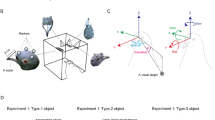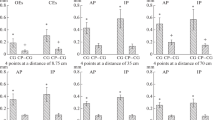Summary
-
1.
Visually guided head and body movements of restrained and freely moving mantids (Tenodera australasiae) have been studied by means of closed circuit television. Interest was concentrated on the different roles of the fovea and the periphery of the eye in controlling visuo-motor behaviour.
-
2.
The peripheral eye is mainly responsible for the detection of novel objects (preferably potential prey) and the generation of ballistic (open-loop) saccadic head movements (Fig. 2) which bring the target image to the fovea (Figs. 3, 4, 5, 6).
-
3.
Measurements on monocular animals show that the fovea ofeach eye is encircled by a saccade sensitive periphery (Figs. 5, 6). In other words each eye is capable of measuring any retinal position of the target image in a coordinate system whose origin is at the fovea. Based on this finding, a hypothesis, which is outlined in Sect. IV.7, suggests that the binocular coordination during fixation, tracking and distance estimation is based on the comparison of angular coordinates extracted by each eye from the position vector of the target.
-
4.
Moving targets which have been fixated are held in the fovea either by smooth or saccadic tracking eye movements. The degree to which either tracking strategy is employed depends mainly on the features of the background, but to some extent also on the velocity of the target.
-
5.
Targets which move against a homogeneous background are tracked by smooth eye movements (Fig. 7). Low target angular velocities are closely matched by the eye velocity. At high target speeds the head lags increasingly behind the target and saccades are periodically required to reduce the position error relative to the fovea.
-
6.
Smooth pursuit eye movements, evoked either by a single target (Fig. 7) or a disrupted background (Fig. 8), are affected primarily by the velocity of the retinal image. While the effects of target and background are similar in this respect, they differ in others. Small objects in the foreground, subtending an angle of only a few degrees on the retina, evoke strong pursuit responses only when they resemble typical prey and project onto the fovea (Fig. 9). On the other hand, the image stabilisation of the background is a stereotyped response that can be evoked whenever a large part of the background moves across the visual field (Fig. 10a). Moreover, responses caused by a moving target in the fovea, and movements of the background in the periphery, are not combined additively (Fig. 10b). The foveal tracking response is weighted more strongly, but because the target is usually small, compared with the background, competing background motion can suppress smooth foveal tracking almost completely.
-
7.
This limitation imposed upon the smooth pursuit system by the presence of a disrupted background (either a stripe pattern in the experimental set-up or grass and other plants in a natural setting) is avoided by the adoption of a strategy of saccadic tracking (Figs. 11, 12, 15, 16). This also applies for the tracking which immediately precedes the catching of prey (Fig. 15). Therefore, the stabilisation of the target image in place on the fovea is not a prerequisite for a successful strike.
-
8.
Up to target angular velocities of about 100 °/s, saccadic tracking is predictive, i.e. the saccades have adequate amplitudes to bring the fovea right on target at the instant the saccade is completed (Fig. 13). This implies that the saccadic system processes not only position information of the target but velocity information as well. It is suggested that this velocity information is provided by the smooth pursuit system. Saccadic tracking would then reflect interactions of two circuits, the velocity coding circuit which in the presence of a homogeneous background also generates smooth pursuit head movements, and the position coding circuit which in the absence of target movement is able to generate saccades on its own.
Similar content being viewed by others
References
Baldus, K.: Experimentelle Untersuchungen über die Entfernungslokalisation der LibellenAeschna cyanea. Z. Vergl. Physiol.3, 475–505 (1926)
Barmack, N.H.: Modification of eye movements by instantaneous changes in the velocity of visual targets. Vision Res.10, 1431–1441 (1970)
Barrós-Pita, J.C., Maldonado, H.: A fovea in the praying mantis eye. II. Some morphological characteristics. Z. Vergl. Physiol.67, 79–92 (1970)
Burkhardt, D., Darnhofer-Demar, B., Fischer, K.: Zum binokularen Entfernungssehen der Insekten. 1. Die Struktur des Sehraumes von Synsekten. J. Comp. Physiol.87, 165–188 (1973)
Carpenter, R.H.S.: Movements of the eyes. London: Pion 1977
Cloarec, A.: Estimation of hit distance byRanatra. Biol. Behav.4, 173–191 (1978)
Collett, T.S.: Peering — a locust behaviour pattern for obtaining motion parallax information. J. Exp. Biol.76, 237–241 (1978)
Collett, T.S., Land, M.F.: Visual control of flight behaviour in the hoverfly,Syritta pipiens L. J. Comp. Physiol.99, 1–66 (1975)
Collett, T.S., Land, M.F.: How hoverflies compute interception courses. J. Comp. Physiol.125, 191–204 (1978)
Collewijn, H.: Optokinetic eye movements in the rabbit. Input-output relations. Vision Res.9, 117–132 (1969)
Demoll, R.: Die Physiologie des Fazettenauges. Erg. Zool.2, 431–516 (1910)
Ditchburn, R.W.: Eye movements and visual perception. Oxford: Clarendon Press 1973
Duelli, P.: Movement detection in the posterolateral eyes of jumping spiders (Evarcha arcuata, Salticidae). J. Comp. Physiol.124, 15–26 (1978)
Fermi, G., Reichardt, W.: Optomotorische Reaktionen der FliegeMusca domestica. Abhängigkeit der Reaktion von der Wellenlänge, der Geschwindigkeit, dem Kontrast und der mittleren Leuchtdichte bewegter periodischer Muster. Kybernetik2, 15–28 (1963)
Franceschini, N.: Sampling of the visual environment by the compound eye of the fly: fundamentals and applications. In: Photoreceptor optics. Snyder, A.W., Menzel, R. (eds.), pp. 98–125. Berlin, Heidelberg, New York: Springer 1975
Friederichs, H.F.: Beiträge zur Morphologie und Physiologie der Sehorgane der Cicindelinen (Coleoptera). Z. Morph. Ökol. Tiere21, 1–172 (1931)
Fuchs, A.F.: The saccadic system. In: The control of eye movements. Bach-y-Rita, P., Collins, C.C., Hyde, J.E. (eds.), pp. 343–362. New York, London: Academic Press 1971
Fuchs, A.F., Luschei, E.S.: Firing patterns of abducens neurons of alert monkeys in relationship to horizontal eye movements. J. Neurophysiol.33, 382–392 (1970)
Heisenberg, M., Wolf, R.: On the fine structure of yaw torque in visual flight orientation ofDrosophila melanogaster. J. Comp. Physiol.130, 113–130 (1979)
Horridge, G.A., Duelli, P.: Anatomy of the regional differences in the eye of the mantisCiulfina. J. Exp. Biol.80, 165–190 (1979)
Horridge, G.A., Sandeman, D.C.: Nervous control of optokinetic responses in the crabCarcinus. Proc. R. Soc. (London) Ser. B161, 216–246 (1964)
Kien, J.: Sensory integration in the locust optomotor system. I. Behavioural analysis. Vision Res.14, 1245–1254 (1974a)
Kien, J.: Sensory integration in the locust optomotor system. II. Direction selective neurons in the circumoesophageal connectives and the optic lobe. Vision Res.14, 1254–1268 (1974b)
Kirmse, W., Lässig, P.: Strukturanalogie zwischen dem System der horizontalen Blickbewegungen der Augen beim Menschen und dem System des Blickbewegungen des Kopfes bei Insekten mit Fixationsreaktionen. Biol. Zentralbl.90, 175–193 (1971)
Land, M.F.: Movements of the retinae of jumping spiders (Salticidae: Dendryphantinae) in response to visual stimuli. J. Exp. Biol.51, 471–493 (1969)
Land, M.F.: Orientation by jumping spiders in the absence of visual feedback. J. Exp. Biol.54, 119–139 (1971)
Land, M.F.: Head movements of flies during visually guided flight. Nature243, 299–301 (1973)
Land, M.F.: Similarities in the visual behaviour of arthropods and men. In: Handbook of psychobiology. Gazzaning, M., Blakemore, C. (eds.). New York: Academic Press 1975
Land, M.F.: Visually guided movements in invertebrates. In: Function and formation of neural systems. Stent, G.S. (ed.), pp. 161–177. Berlin: Dahlem Konferenzen 1977
Land, M.F., Collett, T.S.: Chasing behaviour of houseflies (Fannia canicularis). J. Comp. Physiol.89, 331–357 (1974)
Lea, J.Y., Mueller, C.G.: Saccadic head movements in mantids. J. Comp. Physiol.114, 115–128 (1977)
Levereault, P.: The morphology of the Carolina mantis. Sci. Bull.24, 203–259. The University of Kansas (1938)
Levin, L., Maldonado, H.: A fovea in the praying mantis eye. III. The centering of the prey. Z. Vergl. Physiol.67, 93–101 (1970)
Maldonado, H., Barrós-Pita, J.C.: A fovea in the praying mantis eye. I. Estimation of the catching distance. Z. Vergl. Physiol.67, 58–78 (1970)
Maldonado, H., Levin, L.: Distance estimation and the monocular cleaning reflex in praying mantis. Z. Vergl. Physiol.56, 258–267 (1967)
Maldonado, H., Rodriguez, E.: Depth perception in the praying mantis. Physiol. Behav.8 751–759 (1972)
Maldonado, H., Benko, M., Isern, M.: Study of the role of the binocular vision in mantids to estimate long distances, using the deimatic reaction as experimental situation. Z. Vergl. Physiol.68, 72–83 (1970)
McCann, G.D., Foster, S.F.: Binocular interactions of motion detection fibres in the optic lobes of flies. Kybernetik8, 193–203 (1971)
Mittelstaedt, H.: Zur Analyse physiologischer Regelungssysteme. Verh. Dtsch. Zool. Ges.1951, 150–157 (1951)
Mittelstaedt, H.: Prey capture in mantids. In: Recent advances in invertebrate physiology, Scheer, B.J. (ed.). University of Oregon (1957)
Oyster, C.W., Takahashi, E., Collewijn, H.: Direction-selective retinal ganglion cells and control of optokinetic nystagmus in the rabbit. Vision Res.12, 183–193 (1972)
Pichka, V.E.: Visual pathways in the protocerebrum of the droneflyEristalis tenax (in Russian). Zh. Evol. Biokhim. Fiziol. (USSR)12, 556–559 (1976)
Pick, B.: Visual flicker induces orientation behaviour in the flyMusca. Z. Naturforsch.29c, 310–312 (1974)
Poggio, T., Reichardt, W.: Visual control of orientation behaviour in the fly. II. Towards the underlying neural interactions. Q. Rev. Biophys.9, 377–438 (1976)
Poggio, T. et al.: Visually guided movements (Group report). In: Function and formation of neural systems. Stent, G.S. (ed.), pp. 309–327. Berlin: Dahlem Konferenzen 1977
Reichardt, W., Poggio, T.: Visual control of orientation behaviour in the fly. I. A quantitative analysis. Q. Rev. Biophys.9, 311–375 (1976)
Rilling, S., Mittelstaedt, H., Roeder, K.D.: Prey recognition in the praying mantis. Behaviour14, 164–184 (1959)
Robinson, D.A.: Models of the saccadic eye movement control system. Kybernetik14, 71–83 (1973)
Robinson, D.A.: Eye movement control in vertebrates. Function andformation of neural systems. Stent, G.S. (ed.), pp. 179–195. Berlin: Dahlem Konferenzen 1977
Rossel, S.: Regional differences in photoreceptor performance in the eye of the praying mantis. J. Comp. Physiol.131, 95–112 (1979)
Sandeman, D.C.: A sensitive position measuring device for biological systems. Comp. Biochem. Physiol.24, 635–638 (1968)
Sandeman, D.C., Erber, J., Kien, J.: Optokinetic eye movements in the crab. I. Eye torque. J. Comp. Physiol.101, 243–258 (1975a)
Sandeman, D.C., Kien, J., Erber, J.: Optokinetic eye movements in the crab. II. Responses of Optokinetic interneurons. J. Comp. Physiol.101, 259–274 (1975b)
Schiller, P.H.: The discharge characteristics of single units in the oculomotor and abducens nuclei of the unanesthetized monkey. Exp. Brain Res.10, 347–362 (1970)
Stark, L.: The control system for versional eye movements. In: The control of eye movements. Bach-y-Rita, P., Collins, C.C., Hyde, J.E. (eds.), pp. 363–428. New York, London: Academic Press 1971
Virsik, R.P., Reichardt, W.: Detection and tracking of moving objects by the flyMusca domestica. Biol. Cybern.23, 83–98 (1976)
Wallace, G.K.: Visual scanning in the desert locustSchistocerca gregaria Forskål. J. Exp. Biol.36, 512–525 (1959)
Yarbus, A.L.: Eye movements and vision. New York: Plenum Press 1967
Zaretsky, M., Rowell, C.H.F.: Saccadic suppression by corollary discharge in the locust. Nature280, 583–585 (1979)
Author information
Authors and Affiliations
Additional information
I wish to thank Drs. S.B. Laughlin, M.V. Srinivasan, E.E. Ball and Prof. G.A. Horridge for their critical comments on the manuscript. I am also grateful to Dr. D.C. Sandeman for stimulating discussions throughout the course of this work.
Rights and permissions
About this article
Cite this article
Rossel, S. Foveal fixation and tracking in the praying mantis. J. Comp. Physiol. 139, 307–331 (1980). https://doi.org/10.1007/BF00610462
Accepted:
Issue Date:
DOI: https://doi.org/10.1007/BF00610462




